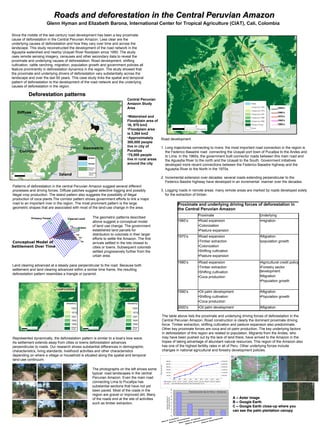
Roads and deforestation in the central peruvian amazon
- 1. Roads and deforestation in the Central Peruvian Amazon Glenn Hyman and Elizabeth Barona, International Center for Tropical Agriculture (CIAT), Cali, Colombia Since the middle of the last century road development has been a key proximate cause of deforestation in the Central Peruvian Amazon. Less clear are the underlying causes of deforestation and how they vary over time and across the landscape. This study reconstructed the development of the road network in the Aguaytia watershed and nearby Ucayali River floodplain since 1950. The study uses remote sensing imagery, censuses and other secondary data to reveal the proximate and underlying causes of deforestation. Road development, shifting cultivation, cattle ranching, migration, population growth and government policies all feature prominently in deforestation dynamics in the region. The study showed that the proximate and underlying drivers of deforestation vary substantially across the landscape and over the last 60 years. This case study links the spatial and temporal pattern of deforestation to the development of the road network and the underlying causes of deforestation in the region. Deforestation patterns Central Peruvian Amazon Study Area 1950’s Diffuse 1960’s •Watershed and 1970’s Floodplain area of 1980’s 16, 970 km2 1990’s •Floodplain area is 3,264 km2 •Approximately Road development 300,000 people live in city of 1. Long trajectories connecting to rivers: the most important road connection in the region is Geometric Corridor Pucallpa the Federico Basadre road connecting the Ucayali port town of Pucallpa to the Andes and •75,000 people to Lima. In the 1960s, the government built connector roads between this main road and live in rural areas the Aguaytia River to the north and the Ucayali to the South. Govenrment initiatives around the city developed more recent connections between the Federico Basadre highway and the Aguaytia River to the North in the 1970s. Island 2. Incremental extension over decades: several roads extending perpendicular to the Federico Basdre highway have developed in an incremental manner over the decades. Patterns of deforestation in the central Peruvian Amazon suggest several different processes and driving forces. Diffuse patches suggest selective logging and possibly 3. Logging roads in remote areas: many remote areas are marked by roads developed solely illegal crop production. The island pattern also suggests the possibility of illegal for the extraction of timber. production of coca plants.The corridor pattern shows government efforts to link a major road to an important river in the region. The most prominent pattern is the large Proximate and underlying driving forces of deforestation in geometric shapes that are associated with most of the land-use change in the area. the Central Peruvian Amazon Proximate Underlying Primary Forest Cleared Land The geometric patterns described above suggest a conceptual model 1960’s •Road expansion •migration T1 of land use change. The government •Colonization Urban established land parcels for •Pasture expansion T2 distribution to colonists in their larger T3 1970’s •Road expansion •Migration efforts to settle the Amazon. The first Conceptual Model of T4 arrivals settled in the lots closest to •Timber extraction •population growth Settlement Over Time cities or towns. Subsequent colonists •Colonization settled progressively further from the •Shifting cultivation urban area. •Pasture expansion 1980’s •Road expansion •Agricultural credit policy Land clearing advanced at a steady pace perpendicular to the road. Because both •Timber extraction •Forestry sector settlement and land clearing advanced within a similar time frame, the resulting development •Shifting cultivation deforestation pattern resembles a triangle or pyramid. •Coca production •Migration •Population growth 1990’s •Oil palm development •Migration •Shifting cultivation •Population growth •Coca production 2000’s •Oil palm development •Migration The table above lists the proximate and underlying driving forces of deforestation in the Central Peruvian Amazon. Road construction is clearly the dominant proximate driving force. Timber extraction, shifting cultivation and pasture expansion also predominate. Other key proximate forces are coca and oil palm production. The key underlying factors in deforestation of this region are related to population. Migrants from the Andes, who Represented dynamically, the deforestation pattern is similar to a boat’s bow wave. may have been pushed out by the lack of land there, have arrived to the Amazon in the As settlement extends away from cities or towns deforestation advances hopes of taking advantage of abundant natural resources. This region of the Amazon also perpendicular to roads. Our research shows substantial differences in demographic has one of the highest fertility rates in all of Peru. Other underlying forces include characteristics, living standards, livelihood activities and other characteristics changes in national agricultural and forestry development policies. depending on where a village or household is situated along the spatial and temporal land-use continuum. 600,000 30,000,000 A B 500,000 25,000,000 Miles de personas 400,000 20,000,000 The photographs on the left shows some 300,000 15,000,000 typical road landscapes in the central 200,000 100,000 10,000,000 5,000,000 Peruvian Amazon. Even the main road 0 1940 1961 1972 1981 1993 2007 2010* 2015* 2020* 0 connecting Lima to Pucallpa has Ucayali Perú 16,154 64,161 120,501 163,208 314,810 432,159 455,497 493,736 530,881 6,207,9679,906,74613,538,20 17,005,2122,048,3527,412,15 substantial sections that have not yet C been paved. Most of the roads in the region are gravel or improved dirt. Many of the roads end at the site of activities A – Aster image such as timber extraction. B – Google Earth C – Google Earth close-up where you can see the palm plantation canopy
